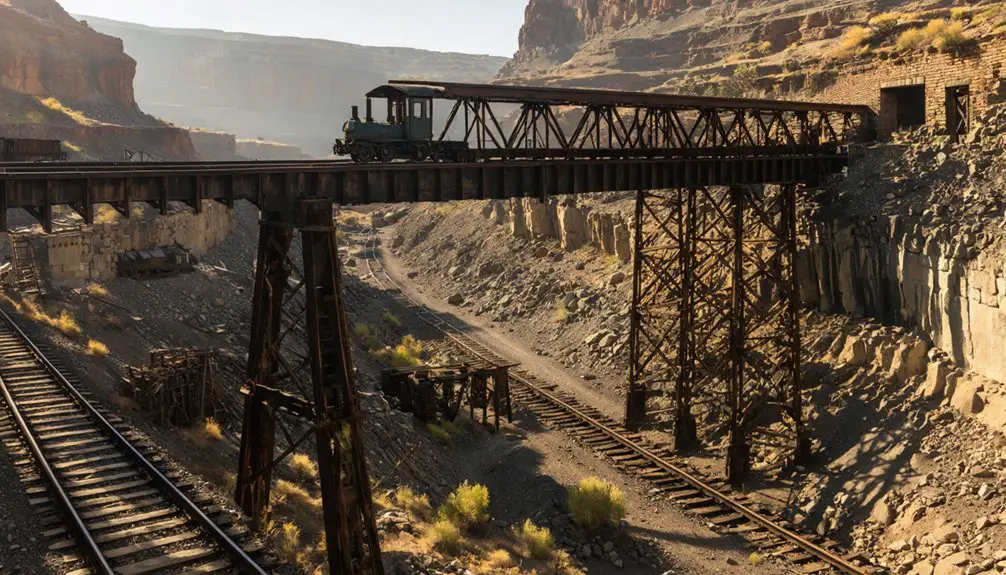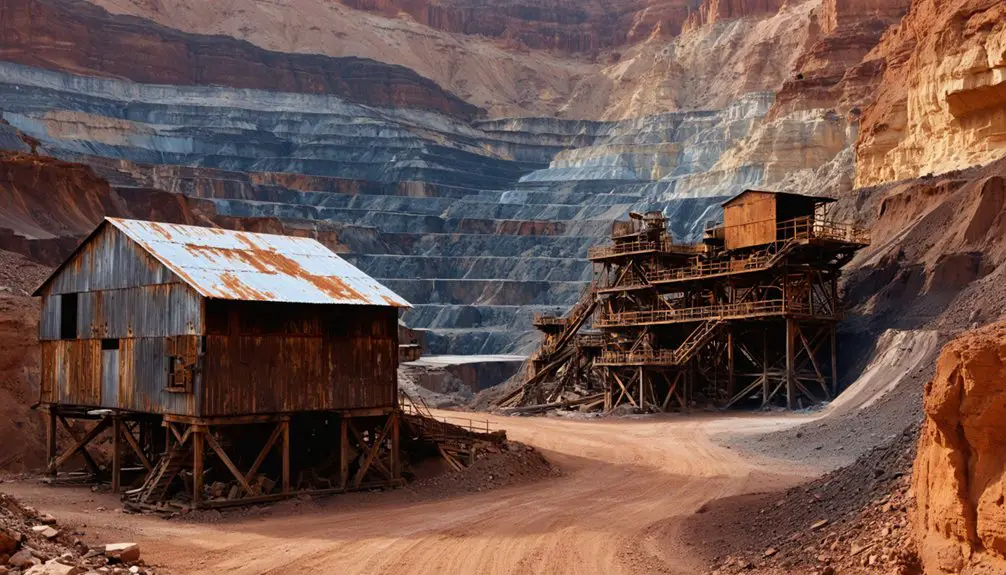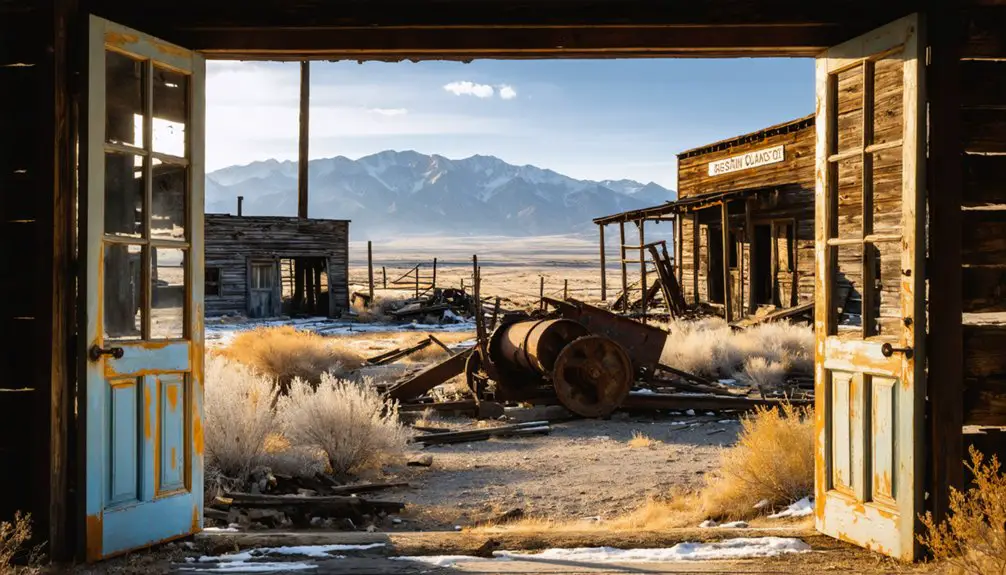If you’re looking for Bingham Canyon, you won’t find the original town anymore – it’s now beneath North America’s largest man-made excavation. The story began in 1848 when Mormon pioneers discovered copper, leading to a thriving multicultural mining town of 20,000 residents by the 1920s. The expansion of open-pit mining gradually swallowed the community, forcing evacuation by 1972. Only nearby Copperton remains, preserving echoes of this remarkable mining heritage.
Key Takeaways
- Bingham Canyon transitioned from a thriving mining town of 15,000-20,000 residents to a ghost town by 1972 due to mine expansion.
- The last residents were evacuated in the early 1970s when mining operations completely displaced the original townsite.
- Only Copperton, built in 1926 away from mining operations, survives today as the sole remaining community.
- The town’s multicultural community, including Italian, French, Irish, and Japanese immigrants, dispersed as mining operations expanded.
- Natural hazards, mine expansion, and systematic residential evacuation led to the disappearance of neighborhoods like Highland Boy and Copperfield.
The Discovery of Copper and Early Settlement Days
While the Bingham brothers’ 1848 discovery of copper ore while grazing cattle would eventually transform Bingham Canyon into one of America’s most significant mining sites, the initial find went largely unexploited.
When they reported their copper discovery to Brigham Young, he advised against mining to prioritize basic survival needs of the settlement.
You’ll find it fascinating that the area’s first real mining activity didn’t begin until 1863, when soldiers from Fort Douglas found silver-lead deposits.
Under General Connor’s leadership, the West Mountain Mining District was established, attracting prospectors from the California gold rush.
Though early settlers tested copper samples in Salt Lake City, they didn’t yet realize its true value.
The first mining claim in the area was established by the Jordan S.M.Co on September 17, 1863.
Transportation costs and inexperience with smelting processes initially hindered successful mining operations in the region.
Rise of a Mining Boomtown
You’ll find it remarkable how Bingham Canyon transformed from early settlers’ dreams of gold strikes into one of the world’s most significant industrial mining operations by the late 1800s.
The arrival of the Utah Central Railroad in 1873 enabled large companies to bring in heavy equipment and establish extensive copper mining operations, forever changing the region’s mining landscape. By 1905, fourteen major mines were actively operating and employing nearly 2,000 workers. The narrow canyon became home to neighborhoods filled with diverse ethnic groups, including Italian, French, Irish, and Japanese immigrants.
As mining operations expanded, Bingham Canyon’s population swelled to nearly 20,000 residents, creating a bustling community of diverse immigrant families who supported the booming copper industry.
Early Settler Discovery Dreams
In August 1848, Mormon pioneers Thomas and Sanford Bingham first glimpsed what would become one of America’s most significant mining districts, though they couldn’t have known it at the time.
You’d find them settling with modest aspirations – building a small cabin and tending livestock in the rugged canyon that would later bear their name.
While grazing cattle, they’d stumble upon traces of copper, gold, and silver, but their settler aspirations weren’t focused on mineral exploration.
Following Brigham Young’s guidance to prioritize survival over mining, they’d leave these discoveries largely unexplored.
By 1850, they’d abandon the canyon for Weber County, their mineral finds temporarily forgotten.
It wasn’t until 1863 that others would establish the first organized mining district, transforming the Binghams’ simple grazing land into a hub of mining activity that would eventually produce over 19 million short tons of copper throughout its history.
Industrial Mining Takes Hold
Despite the Binghams’ modest beginnings, industrial-scale mining transformed their pastoral canyon into one of America’s most significant copper producers by the early 1900s.
The implementation of open pit mining in 1909 marked a revolutionary shift in extraction methods. You’d hardly recognize the sleepy settlement as mining innovations revolutionized operations. The formation of Utah Copper Company in 1903 and Boston Consolidated in 1898 ushered in an era of dramatic industrial growth. This growth continued when Kennecott Copper Corporation purchased Utah Copper Company in 1936, further consolidating mining operations in the region.
Population Explosion Transforms Community
While Mormon pioneers Thomas and Sanford Bingham first settled the canyon in 1848, the area’s true population surge didn’t begin until the 1870s when the railroad’s arrival transformed this remote outpost into a bustling mining community.
The population dynamics shifted dramatically as mining operations expanded. You’d have found an incredibly diverse immigrant workforce flooding into Bingham Canyon – Welsh, Irish, and Cornish miners were soon joined by workers from across the globe. Distinct neighborhoods like Copperfield and Japtown emerged as different ethnic groups established their own communities. The area’s reputation for diversity earned it the nickname “League of Nations” by the 1920s.
By the 1920s, over 15,000 residents called Bingham home. The once-quiet canyon had become a thriving industrial city, complete with schools, businesses, and social institutions.
Large mining corporations like the Bingham Copper and Gold Mining Company drew even more workers, making the town a melting pot of cultures united by the promise of mining prosperity.
Life in the Company Towns
Living in Bingham Canyon’s company towns meant adapting to a unique way of life shaped by the copper industry’s demands.
You’d find yourself among a diverse community where 65% of your neighbors were immigrants, all drawn by the promise of work in the mines and mills. The community dynamics reflected both unity and division – while workers shared tight quarters along a single street stretching seven miles through the canyon, management enjoyed more luxurious accommodations in places like Copperton.
Labor relations defined daily life, with companies controlling not just your work but your housing too.
Still, towns like Garfield offered modern amenities including schools, churches, and medical care. You could eventually buy your company-owned home, though you’d need to be prepared to move it if the expanding mine operations required your land.
From Underground to Open-Pit Mining

While you’d have seen plenty of underground mining activity in Bingham Canyon during the 1860s-1890s, the eventual depletion of high-grade ores posed serious economic challenges for the mining companies.
Steam shovels arrived in 1906, marking a revolutionary shift toward open-pit mining that could efficiently extract vast quantities of lower-grade ore.
This technological transformation, championed by Daniel Jackling and Robert Gemmell, proved so successful that it completely replaced the old underground tunnels and shafts that had once defined Bingham Canyon’s mining landscape.
Underground Mining Challenges Emerge
As Bingham Canyon’s early mining operations expanded in the late 1800s, miners faced increasingly dangerous conditions in the underground workings.
You’d find men toiling in poorly lit tunnels, breathing toxic fumes and gas while hauling ore with mule-drawn trams. These underground hazards made every shift a gamble with fate.
The mining limitations became more apparent as operations pushed deeper into the earth. You couldn’t extract enough ore through traditional stoping and block caving methods to make the low-grade deposits profitable. The transition to open-pit copper mining would revolutionize the industry’s approach to extracting low-grade ores.
Imagine maneuvering through narrow passages while dealing with flooding risks and unstable ground. The deeper they dug, the more complex and treacherous the geology became, forcing miners and companies to recognize that underground mining at Bingham Canyon wasn’t sustainable for the long term.
Steam Shovels Transform Mining
Steam shovels revolutionized mining at Bingham Canyon in 1906, ushering in a new era of open-pit operations that would forever change Utah’s mining landscape.
You’ll find it hard to imagine the transformation from underground block caving to mechanized excavation, as steam shovels ripped through waste rock to expose valuable copper ore deposits below.
These powerful machines didn’t just replace mules and manual labor – they completely transformed how you’d approach mining. The efficiency gains were staggering, allowing miners to extract low-grade ore that wasn’t economically viable before.
Working alongside the newly built Bingham & Garfield Railroad, steam shovels helped turn a collection of rough mining camps into bustling communities of 20,000 people.
Mining efficiency soared as these mechanical giants carved out what would become known as “the richest hole on earth.”
Peak Population and Community Development
During the early 20th century, Bingham Canyon transformed from a modest mining settlement into a bustling multicultural hub, reaching its peak population of 15,000-20,000 residents by the 1920s.
You’d have found a vibrant “League of Nations” where community dynamics revolved around distinct immigrant neighborhoods, with 65% of residents being foreign-born. These newcomers from Britain, Ireland, Greece, Japan, and many other nations created their own ethnic enclaves like “Japtown” while working together in the mines.
The town’s incorporation in 1904 brought formal development, anchored by the Bingham Mercantile.
As the community stretched seven miles along the canyon, you’d have discovered churches, social clubs, and mutual aid societies that supported the diverse population through the challenges of mining life.
Transportation and Infrastructure

The transportation backbone of Bingham Canyon took shape in 1907 with the groundbreaking construction of the Bingham-Garfield Railway, expanding far beyond the town’s early immigrant neighborhoods.
You’ll marvel at the railway innovations that transformed this mining town, as the line hauled an impressive 10,000 tons of copper ore daily by 1911.
If you’d ventured here in the 1920s, you’d have witnessed remarkable transport logistics evolving, with steam engines giving way to electric locomotives.
The railway didn’t just move ore – it carried workers, equipment, and supplies that kept the community thriving.
Through challenging terrain and multiple tunnels, this essential artery set national records for ore hauling by the 1940s, though it wasn’t without its dangers, as evidenced by the tragic 1942 tunnel explosion that claimed two lives.
The Decline of Residential Areas
While Bingham Canyon‘s mining operations thrived in the early 1900s, its residential areas faced mounting challenges that would ultimately lead to their demise.
You’d have found homes precariously perched along a single winding street, where natural hazards like fires and avalanches constantly threatened residents’ safety. The Great Depression dealt another blow, with Utah’s unemployment rate hitting 36% by 1932, forcing many mining families to abandon their homes.
As the mine expanded, you would’ve witnessed systematic residential evacuation throughout the canyon. Highland Boy and Copperfield vanished by 1960, followed by Bingham’s complete community displacement by 1972.
Only Copperton, built in 1926 as a planned community on safer ground, survived. It’s where you’ll find the last remnants of the area’s mining heritage today.
Legacy of a Mining Giant

Beyond the vanished homes and displaced communities lies an extraordinary geological legacy that shaped modern mining.
You’ll find that Bingham Canyon’s mining heritage revolutionized copper extraction worldwide through innovations like the flotation process and large-scale open-pit operations.
When Daniel Jackling proved that low-grade ore could be profitably mined, he triggered an economic transformation that would change mining forever.
Frequently Asked Questions
What Happened to the Original Buildings and Structures After the Town’s Abandonment?
By 1972, you’d find zero structural remnants since Kennecott Copper razed 100% of buildings for mine expansion. There’s no physical exploration possible today – the entire town lies beneath the massive open-pit mine.
Were There Any Major Mining Accidents or Disasters in Bingham Canyon?
You’ll find two major disasters: the 2013 Manefay Slides moved 145 million tons of rock, showcasing advanced mining safety protocols, and a 1969 tunnel collapse where rescuers saved Buck Jones after five days.
What Native American Tribes Originally Inhabited the Bingham Canyon Area?
Imagine vast hunting grounds where ancient footprints tell stories. You’ll find the Shoshone and Bannock peoples were primary inhabitants, though neighboring Ute and Goshute tribes also traversed these ancestral mountain lands.
How Did Pollution From Mining Operations Affect Local Wildlife and Vegetation?
You’ll find the area suffered massive wildlife decline due to toxic metals and chemicals, while vegetation loss occurred from soil contamination, acid rain, and excavation destroying natural habitats and ecosystems.
Did Any Famous People or Historical Figures Visit Bingham Canyon?
When you visit the mine today, you’re walking where famous visitors like Brigham Young and Daniel C. Jackling once stood. They’re among many influential figures who shaped this historic mining powerhouse.
References
- https://www.copper.org/publications/newsletters/innovations/1998/05/kennecott.html
- https://en.wikipedia.org/wiki/Bingham_Canyon_Mine
- https://www.mininghistoryassociation.org/Meetings/ParkCity2024/Bingham Canyon Orientation Guide FINAL AO31.pdf
- https://nhmu.utah.edu/sites/default/files/trail-resource/Rio Tinto.pdf
- https://utahrails.net/bingham/bingham-1936-1981.php
- https://utahrails.net/bingham/bingham-discovery.php
- https://www.kennecott-groundbreakers.com/stories/the-bingham-mine—our-national-historic-landmark
- https://www.uen.org/utah_history_encyclopedia/b/BINGHAM_CANYON.shtml
- https://westernmininghistory.com/towns/utah/bingham/
- https://utahrails.net/bingham/bingham-1900-1914.php



